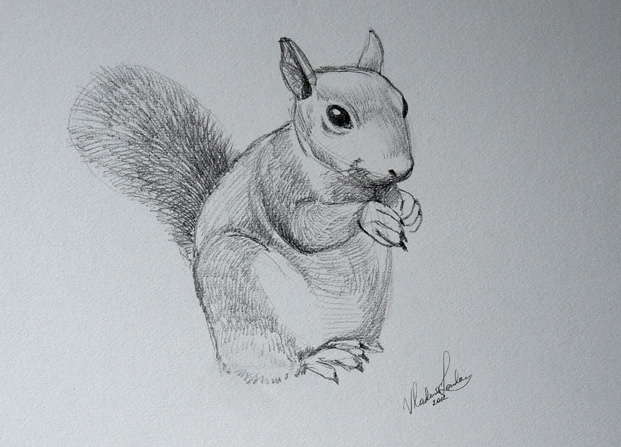Discover How to Draw an Animal
In this video lesson, you will discover How to Draw an Animal on example of a squirrel drawing in quick and realistic manner.
Enroll in the Drawing Academy Course
Pay once - Enjoy forever!
Only $297
How to Draw an Animal – Squirrel Drawing
In this “How to Draw an Animal” video lesson we will do the sketch in soft grade pencil. 2B to 4B graphite pencil is well-suited for this task. The squirrel has a rounded head, which for now, is marked as an oval with one pointed end. Its body is another organic looking shape that is roughly represented with a bigger oval underneath. Its big mass of a bushy tail is marked as a peanut shape, for the time being.
When it comes to the topic of “How to Draw an Animal“, a fine artist can learn a great deal about animals observing them in nature.

I draw the squirrel’s big dark eyes – making a high contrast between the reflected spot of light and the dark eyeball. The eyes are positioned high and slightly to the sides of their head. It provides a wide field of view in binocular vision, so squirrels can see in stereo.
These animals have very good eyesight, which helps them judge distances with great accuracy and navigate accurately.
A ring of pale fur circles the squirrel’s eyes is depicted with lighter pencil-strokes.
I draw the squirrel’s forelimbs, which are clenching a nut. They are strong and well designed for grasping food.
The squirrels’ fur is soft and grows much thicker during winter to provide better insulation from cold weather. Squirrels have been hunted for many centuries for their winter fur. I draw the fur texture with short, soft hatching of parallel pencil strokes.
When you consider ‘how to draw an animal’ like a squirrel, keep in mind that there are three main types of squirrels: tree squirrels, ground squirrels and flying squirrels. Our squirrel originally came from Eastern America and mostly lives in trees.
Squirrels have found their habitat on all continents apart from Antarctica. They live in forests and deserts and exploit many ecological niches including, city gardens and backyards.
With their front paws they can manipulate food and, in the case of tree squirrels, climb trees. Squirrels have long toes with claws. The claws are strong and sharp; they give good support when the squirrel climbs up and down tree trunks and branches. Squirrels have hard pads of skin on the soles of their feet; they walk on their soles.
On their heads, squirrels have four sets of sensitive whiskers, also called vibrissae. They are located above and below their eyes, in front of their throat and alongside their nose. These vibrissae act as touch receptors “feeling” the squirrel’s immediate environment.
Squirrels have large ears that are highly sensitive to sound. I draw the shaded inner part of the ear darker, while leaving un-rendered the outer plane, which is well lit with light.
Squirrels have an excellent sense of smell, which even helps them to detect food that is buried underground.
Squirrels also have touch-sensitive vibrissae on their wrists, which helps them “feel” their way on the move.
Most of the squirrel’s active time is spent on foraging. Many species, including the Eastern Gray Squirrel, hide food in caches. They bury nuts and seeds just below the topsoil, hide pinecones in burrows and store fungi in trees. I’m not sure if they have a good memory as to where they’ve stored the food, maybe squirrels rely on their good sense of smell to find caches later on. Many caches left unfound are often hidden seeds and nuts, which germinate. New trees like oak and beech can grow from such caches. That is how squirrels help with forest regeneration.
Apart from nuts, grey squirrels feed on a wide variety of foods, including: fruits, seeds, buds, flowering spike of trees, lichens, etc. Squirrels can eat mushrooms that can poison or even kill other animals. Their stomachs contain glycoprotein, which bonds with the toxic elements of fungi and make it indigestible. They also will eat insects, small frogs and other vertebrates, as well as, birds’ eggs.
A squirrel’s front teeth, or incisors, grow throughout the animal’s life. Squirrels gnaw persistently to wear down these teeth to prevent them from overgrowing. Their front teeth are also very strong and sharp, as I have found out from my own experience. Squirrels can easily cut open the hard outer shells of nuts and seeds.
A squirrel’s bushy tail is an interesting point of a drawing. It has long hairs of fur that can be depicted in longer pencil strokes. The tail is a three-dimensional object. The fine artist needs to understand its shape and volume to depict it realistically.
A squirrel’s tail serves a multiple functions. It is used for balance when the squirrel runs and climbs trees and acts as a rudder when leaping. It is also used for communication, signalling to other squirrels when danger threatens. A squirrel rapidly flicks its tail from side to side and erects the long brush hairs when threatened. Other squirrels can see and understand these signals of danger.
A squirrel’s tail is as long as its body, therefore, it can be used to provide shade during hot weather and insulate this animal during cold nights.




